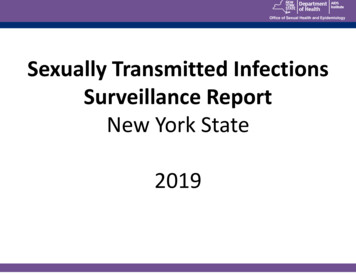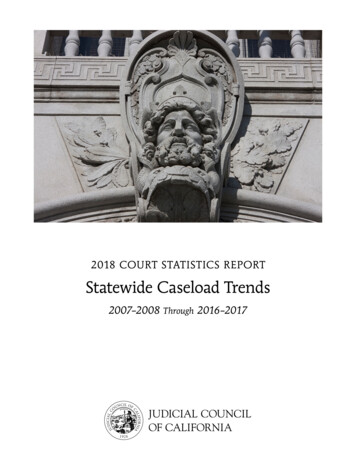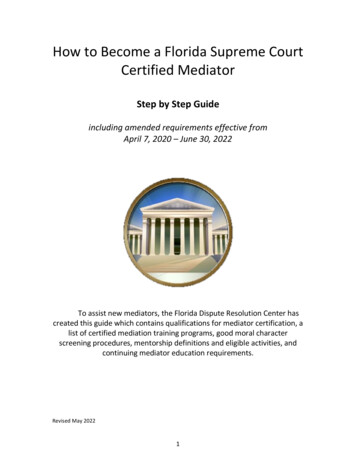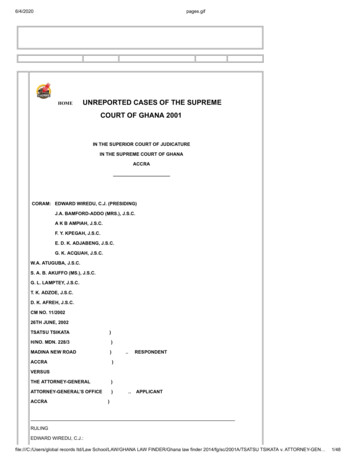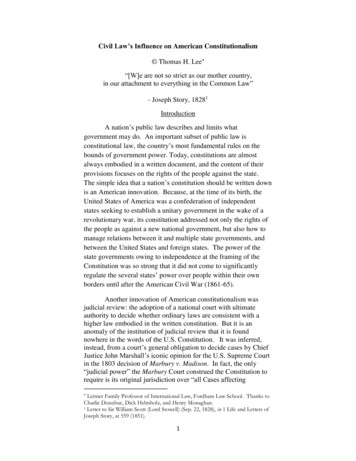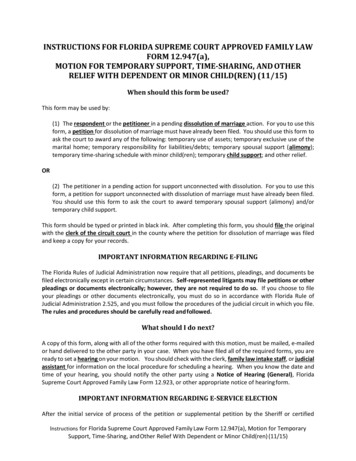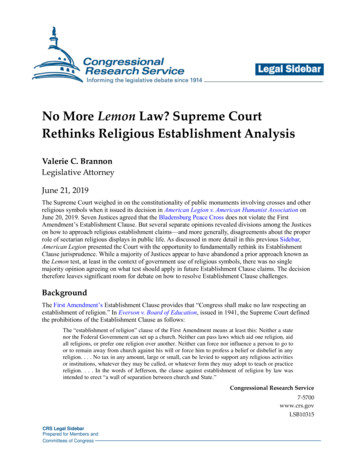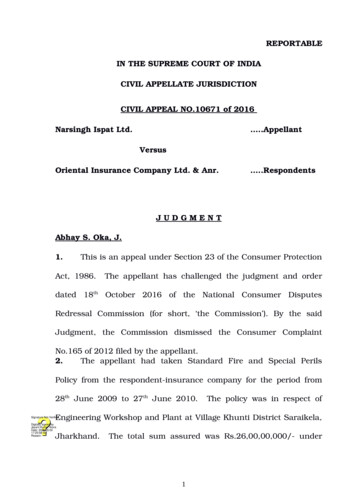
Transcription
REPORTABLEIN THE SUPREME COURT OF INDIACIVIL APPELLATE JURISDICTIONCIVIL APPEAL NO.10671 of 2016Narsingh Ispat Ltd. .AppellantVersusOriental Insurance Company Ltd. & Anr. .RespondentsJUDGMENTAbhay S. Oka, J.1.This is an appeal under Section 23 of the Consumer ProtectionAct, 1986.The appellant has challenged the judgment and orderdated 18th October 2016 of the National Consumer DisputesRedressal Commission (for short, ‘the Commission’). By the saidJudgment, the Commission dismissed the Consumer ComplaintNo.165 of 2012 filed by the appellant.2.The appellant had taken Standard Fire and Special PerilsPolicy from the respondent insurance company for the period from28th June 2009 to 27th June 2010.The policy was in respect ofEngineering Workshop and Plant at Village Khunti District Saraikela,Signature Not VerifiedDigitally signed byJayant Kumar AroraDate: 2022.05.0217:25:58 ISTReason:Jharkhand.The total sum assured was Rs.26,00,00,000/ under1
different headings. The appellant paid a premium of Rs.2,20,462/ .According to the appellant, the policy covered the loss caused to theproperty of the appellant on account of fire, lightning, explosion, riots,strike etc.3.The appellant lodged a claim on the basis of the said policy,based on the incident of 23rd March 2010. As per the claim made bythe appellant, after midnight of 22nd March 2010, about 50 60 anti social people with arms and ammunition entered the factory premisesof the appellant at Village Khunti, District Saraikela in Jharkhand.According to the appellant’s case, the mob demanded money and jobsfor local people. According to the case of the appellant, substantialdamage was caused to its factory, machinery and other equipment.According to the appellant, the object of the incident was to terrorisethe management of the appellant and workers in the factory byforcing them to pay a ransom to the miscreants. A First InformationReport was also registered at the instance of the appellant based onthe said incident.The appellant lodged a regular claim with therespondent company on the basis of the policy.According to theappellant’s case, a surveyor appointed by the respondent insurancecompanycarriedRs.89,43,422/ .outthesurveyandassessedthelossatHowever, by addressing a letter on 21st December2010, the appellant claimed that the respondent insurance companywas liable to make an interim payment of Rs.1.5 crores.2
4.By the letter dated 23rd December 2010, the respondent insurance company repudiated the appellant’s claim by placingreliance on the Exclusion Clause in the policy regarding loss ordamage caused by the acts of terrorism. Therefore, the appellant filedthe complaint mentioned above before the Commission complainingabout deficiency in the service offered by the respondent insurancecompany.In the complaint, a prayer was made for the grant ofmonetary relief of Rs.1,51,35,780/ on account of the loss suffered bythe appellant. A separate amount of Rs.25,00,000/ was claimed onaccount of agony and harassment caused to the appellant due toillegalrepudiationofthepolicybytherespondent insurancecompany. The appellant claimed interest at the rate of 18% p.a onthe amounts mentioned above and cost amount of Rs.10,00,000/ .5.By the impugned judgment and order, the Commission heldthat because of the “Terrorism Damage Exclusion Warranty” (forshort, ‘the Exclusion Clause’), the respondent company was justifiedin repudiating the claim of the appellant based on the policy ofinsurance. It was held that the damage caused to the factory andequipment of the appellant was due to an act of terrorism.6.For the sake of convenience, we are reproducing the saidExclusion Clause, which reads thus:“Terrorism Damage Exclusion Warranty :Notwithstanding any provision to the contrary within this3
insurance it is agreed that this insurance excludes loss,damage cost or expense of whatsoever nature directly orindirectly caused by, resulting from or in connection withany act of terrorism regardless of any other cause orevent contributing concurrently or in any other sequenceto the loss.For the purpose of this endorsement an act ofterrorism means an act, including but not limited tothe use of force or violence and/or the threat thereof,of any person or group(s) of persons whether actingalone or on behalf of or in connection with anyorganization(s) or government(s), committed forpolitical, religious, ideological or similar purposeincluding the intention to influence any governmentand/or to put the public, or any section of the publicin fear.The warranty also excludes loss, damage, cost orexpenses of whatsoever nature directly or indirectlycaused by, resulting from or in connection with anyaction taken in controlling, preventing, suppressing or inany way relating to action taken in respect of any act ofterrorism.”(emphasis added)7.Shri Santosh Kumar, the learned counsel appearing for irstInformation Report against unknown persons. After completing theinvestigation, the police filed a closure report recording that theaccused could not be traced.He submitted that though therespondent insurance company relied upon the Investigation Reportin the letter of repudiation, neither a copy thereof was supplied to theappellant nor was it produced before the Commission.He pointedout that after this Court issued a specific direction, a copy of the4
Investigation Report was filed on record by the respondent, whichrecords that it was not conclusively proved that Maoist activists orany such activists made the attack. He submitted that on a conjointreading of the First Information Report, closure Report filed by thepolice and Investigation Report submitted by the Investigatorappointed by the respondent insurance company, it is apparent thatit was not a case of a terrorist act within the meaning of theExclusion Clause. The learned counsel tried to rely upon the conceptof ‘terrorism’ under various enactments such as the UnlawfulActivities (Prevention) Act, 1967 and the National InvestigationAgency Act, 2006.He submitted that the burden was on theinsurance company to prove that the Exclusion Clause was attractedin the facts of the case. He submitted that if there was any ambiguityabout whether the Exclusion Clause was attracted, the insurancecontract will have to be construed in favour of the appellant insurer.In support of this proposition, he relied upon a decision of this Courtin the case of National Insurance Co. Ltd. v. Ishar Das Madan Lal1.8.The learned counsel appearing for the appellant submitted thateven according to the report of the surveyor appointed by therespondent company, the damage caused to the machinery andequipment has been quantified at approximately Rs.89,00,000/ . Hesubmitted that by setting aside the impugned judgment and order,1 (2007) 4 SCC 1055
the respondent company may be directed to pay a sum ofRs.89,00,000/ to the appellant along with interest, and theCommission may be directed to consider the case of the appellant forgrant of additional amount based on the evidence on record.9.Shri Santosh Paul, the learned senior counsel appearing forthe respondent insurance company, invited our attention to theallegations made in the First Information Report regarding theincident of 23rd March 2010.He submitted that the fact that 120people entered the factory premises of the appellant along withweapons and carried out large scale destruction shows that it was anact of terrorism to terrorise the workers of the appellant and itsmanagement.He submitted that the police have applied Sections147, 148, 149, 323, 307, 379, 427, 435 and 447 of the Indian PenalCode read with Section 17 of the Criminal Law (Amendment) Act,1908 (for short, ‘the Amendment Act of 1908’). He submitted that itwas a case of unlawful association as defined in Section 15 of theAmendment Act of 1908.He submitted that under Section 17thereof, the unlawful association is made an offence. He submittedthat the very fact that the provisions of the Amendment Act of 1908have been applied shows that the loss caused to the appellant wasdue to a terrorist act.He submitted that the burden was on theappellant to show that liability arises under the said policy.6He
submitted that the appellant failed to discharge the burden.Hewould, therefore, submit that no interference is called for with thefinding of the Commission.10.We have given a careful consideration to the submissions ofthe rival parties. In its letter dated 23 rd March 2010 addressed to therespondent, the version of the appellant of the incident whichoccurred around 12:30 a.m. on 23 rd March 2010 has been stated. Therelevant part of the letter reads thus:“With reference to the above and continuation to verbalinformation given to you over telephone, our submissionsare as follows :Please note that in last midnight 12.30 A.M. around 50 60 antisocial peoples with arm ammunitions entered intofactory premises through back side door of the factorypremises.Some of them marched towards DG Room and got firedone DG and tried to destroy it.Some of them moved towards control room of blastfurnace and damaged control system of Blast Furnaceavailable in control room and beaten the men workingthere.They have also damaged Security room, office room andcomputers available there.They have taken away around 15 Nos. of mobile phone,walky talky sets and cash found in drawer of factoryoffice premises, materials particularly relating to PIGIrons.Company people informed immediately to the nearestpolice station over telephone.7
Since blast furnace need continuous working and once itis cooled and to get it reheated it would have been cost tothe Company for Rs.30 45 lakhs so that Co operativeHousing Society Limited people took immediate steps fordamaged control in main blast furnace.You are requested to kindly look into the matter veryseriously and appoint Surveyors who can visit the site atthe earliest possible manner.”In the subsequent letter dated 15 th April 2010, the appellant statedthat the purpose of the anti social persons was to create terror sothat the appellant would be forced to pay a ransom. We have alreadyreproduced the Exclusion Clause, which defines the act of terrorism.Given the definition, the actions can be termed as acts of terrorismprovided the same are committed for political, religious, ideological orsimilar purposes. The words “similar purposes” will have to beconstrued ejusdem generis.11.In the present case, the repudiation of the policy made by therespondent is based on the Preliminary Survey Report, InvestigationReport and the Final Survey Report.The Survey Reports cannotthrow any light on the question whether there was an act ofterrorism. The Survey Reports do not record any factual findingsregarding the incidents which caused the loss. Reliance was placedon the Investigation Report in the letter of repudiation. A copy of thesaid Report, placed on record along with I.A. No.38075 of 2022,records a conclusion drawn by the Investigator appointed by the8
respondent that it is not conclusively proved that the personsinvolved in the incident belonged to Maoist or similar groups. The FIRand Closure Report do not refer to acts of terrorism as defined underExclusion Clause. The Final Report (Closure Report) shows that thepolice had registered a First Information Report against 105miscreants who could not be traced.12.In paragraph 8 in the case of Ishar Das Madan Lal1, this Courtheld thus:“8. However, there may be an express clause excluding theapplicability of insurance cover.Wherever such anexclusionary clause is contained in a policy, it would befor the insurer to show that the case falls within thepurview thereof. In a case of ambiguity, it is trite, thecontract of insurance shall be construed in favour ofthe insured.[See United India Insurance Co. Ltd. v.Pushpalaya Printers (2004) 3 SCC 694, Peacock Plywood (P)Ltd. v. Oriental Insurance Co. Ltd. (2006) 12 SCC 673 andUnited India Insurance Co. Ltd. v. Kiran Combers & Spinners(2007) 1 SCC 368]”(emphasis added)13.The respondent has not discharged the burden of bringing thecase within the four corners of the Exclusion Clause. When the policyitself defines the acts of terrorism in the Exclusion Clause, the termsof the policy being a concluded contract will govern the rights andliabilities of the parties. Therefore, the parties cannot rely upon thedefinitions of ‘terrorism’ in various penal statutes since the ExclusionClause contains an exhaustive definition of acts of terrorism.9
14.Thus, the Commission committed an error by applying theExclusion Clause. Moreover, the policy specifically covers the damageto the insured’s property caused by violent means. We arereproducing the relevant clause in that behalf :“V. Riot Strike and Malicious DamageLoss of or visible physical damage or destructionby external violent means directly caused to theproperty insured but excluding those caused bya) total or partical (sic) cessation of work or theretardation or interruption or (sic) cessation or anyprocess or operations or omissions of any kind.b) Permanent or temporary dispossession resultingfrom confiscation, commandeering, requisition ordestruction by order of the Government or anylawfully constituted Authority.c) Permanent or temporary dispossession of anybuilding or plant or unit of (sic) machineryresulting from the unlawful occupation by anyperson of such building or plant or unit ormachinery or prevention of access to the same.d) Burglary, housebreaking, theft, larceny or anysuch attempt or any omission of any kind of anyperson (whether or not such act is committed inthe course of a disturbance of public peace) in anymalicious act.If the Company alleges that the loss/damage is notcaused by any malicious act, the burden of proving thecontrary shall be upon the insured.”(emphasis added)The policy covers explicitly a liability arising out of the damage to the10
property of the insured due to riots or the use of violent means.Hence, the decision to repudiate the policy cannot be sustained.Under the insurance policy, there are different limits prescribed forvarious acts covered by the policy. In the impugned Judgment, it isnoted that the parties had filed affidavits in lieu of evidence beforethe Commission.An adjudication will have to be made on thequantum of the amount payable to the appellant after appreciatingthe evidence on record, including the valuation reports. However, thevaluer appointed by the respondent company has valued the losscaused to the appellant at approximately Rs.89,00,000/ .We,therefore, propose to direct the respondent to deposit the said amountwith the Commission with liberty to the appellant to make anapplication for withdrawal.15.As there was no warrant for applying the Exclusion Clause, theimpugned judgment and order will have to be set aside, and byrestoring the complaint filed by the appellant, the same will have tobe ordered to be heard by the Commission afresh.16.Accordingly, the impugned judgment and order is hereby setaside. Consumer Complaint No.165 of 2012 filed by the appellantbefore the Commission is restored to the file. After allowing parties tolead further evidence, the Commission shall decide the complaintfiled by the appellant in accordance with law and in the light of what11
is held in this judgment. The Commission is requested to pass anappropriate final order on the remanded complaint within fourmonths from today. We make it clear that we have not expressed adefinitive opinion on the quantum of the amount payable to theappellant under the policy of insurance, and the said issue is leftopen for the decision of the Commission in accordance with law.17.As observed earlier, the respondent shall deposit the sum ofRs.89,00,000/ in the Registry of the Commission within one monthfrom today and the same shall be deposited in the interest bearingaccount on auto renewal basis. At the same time, the appellant willbe at liberty to file an application for withdrawal of the amount beforethe Commission pending complaint. If such an application is filed bythe appellant, the Commission may examine on its own merits anddecide the same in accordance with law.18.Accordingly, the appeal is allowed in the above terms with noorder as to costs. .J.[AJAY RASTOGI] .J.[ABHAY S. OKA]New DelhiMay 02, 2022.12
insurance company to prove that the Exclusion Clause was attracted in the facts of the case. . 147, 148, 149, 323, 307, 379, 427, 435 and 447 of the Indian Penal Code read with Section 17 of the Criminal Law (Amendment) Act, 1908 (for short, 'the Amendment Act of 1908'). .


